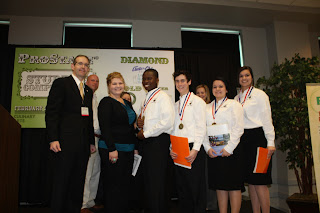The Louisiana Restaurant Association Education Foundation (LRAEF) will host its 12th
Annual Louisiana Seafood ProStart® Student Competition, March 5-6,
2013 at the Pontchartrain Center in Kenner, Hall A. A total of $872,000 in
scholarship opportunities will be awarded to students whose teams place in the
top three in both the culinary and management competitions. The funds were
donated from nine of the leading post-secondary culinary and hospitality
programs in the country, including Louisiana Culinary Institute, Le Cordon Bleu
and University of New Orleans School of Hotel, Restaurant and Tourism, among
others. This year begins a multi-year relationship with the Louisiana Seafood
Promotion & Marketing Board, the competition’s title sponsor.
 The
competition showcases the culinary and academic talents of high school junior
and senior ProStart students from 17 schools across Louisiana. The competition
features two primary components: the Culinary Competition and the Management Competition.
The
competition showcases the culinary and academic talents of high school junior
and senior ProStart students from 17 schools across Louisiana. The competition
features two primary components: the Culinary Competition and the Management Competition.
During
the Culinary Competition, Tuesday, March
5 from 10:45 a.m. – 3 p.m., teams will demonstrate their creative abilities
through the preparation of a three-course, gourmet meal consisting of: a soup,
salad or appetizer; a protein such as meat, fish or fowl, vegetable and starch;
and a cold or flambé dessert. All teams’ menus must have at least one type of
Louisiana seafood. Twenty-one judges from the foodservice industry, and
post-secondary educational institutions will observe and rate their performance
during the competition.
Teams
participating in the Management Competition,
Wednesday, March 6 from 8:30 a.m. – 1:35 p.m., will demonstrate their knowledge
of the restaurant and foodservice industry by developing a restaurant proposal,
delivering a verbal presentation and applying critical thinking skills to
challenges managers face in day-to-day operations. Their performance will be
observed and rated by 14 judges from leading colleges and universities and
industry professionals.
 The
2013 LRAEF ProStart Student Competition Sponsors
include: Louisiana Seafood, Acme Oyster House, Auto-Chlor Services,
Louisiana Hospitality Foundation, Performance Foodservice Caro, Atmos Energy,
Louisiana Culinary Institute, Ocean Conservancy, Ovations, ECOLAB, Notini’s
Restaurant, Capitol City Produce, Centerplate, Drago’s Seafood Restaurant,
Freeman Decorating, Pontchartrain Convention & Civic Center, Reinhart Foodservice
and Sysco New Orleans.
The
2013 LRAEF ProStart Student Competition Sponsors
include: Louisiana Seafood, Acme Oyster House, Auto-Chlor Services,
Louisiana Hospitality Foundation, Performance Foodservice Caro, Atmos Energy,
Louisiana Culinary Institute, Ocean Conservancy, Ovations, ECOLAB, Notini’s
Restaurant, Capitol City Produce, Centerplate, Drago’s Seafood Restaurant,
Freeman Decorating, Pontchartrain Convention & Civic Center, Reinhart Foodservice
and Sysco New Orleans. |
| Budding culinarians compete live and produce awe inspiring cuisine at the Louisiana Seafood ProStart Competition, March 5-6, 2013. |
ProStart
is a two-year comprehensive culinary management course for juniors and seniors
in high school with two primary outcomes: to prepare students for higher
education and to train students to go directly to work in Louisiana’s foodservice
industry. The LRAEF pairs ProStart students and LRA members together in a
mutually-beneficial relationship. Students are required to complete a 400-hour
work internship, thus providing hands-on training. Many of LRA members serve as
mentors to ProStart students.
The
participating schools in the Management Competition are: East St. John HS, Fontainebleau HS, Hammond High Magnet School, Lakeshore HS, N. Vermillion HS, Rayne HS, Salmen HS, Slidell HS and Woodlawn HS.
The participating schools in the Culinary Arts Competition are: Ascension Parish Center for Excellence, East St. John HS, Fontainebleau HS, Grace King HS, Hammond High Magnet School, Lakeshore HS, Mandeville HS, N. Vermillion HS, Rayne HS, Salmen HS, Slidell HS, St. James Career Center, Thibodaux HS, WD Smith Career Center, W. Feliciana HS, West St. John HS and Woodlawn HS.
The winning teams will go on to represent Louisiana at the National ProStart Invitational in Baltimore, Md. April 19-21, 2013.





 The NRA's research also shows that nearly one-third of American adults would like to receive a restaurant gift card as a Valentine’s Day gift. Men show a much stronger preference for restaurant gift cards as a Valentine’s Day gift than women do at nearly half.
The NRA's research also shows that nearly one-third of American adults would like to receive a restaurant gift card as a Valentine’s Day gift. Men show a much stronger preference for restaurant gift cards as a Valentine’s Day gift than women do at nearly half. 
